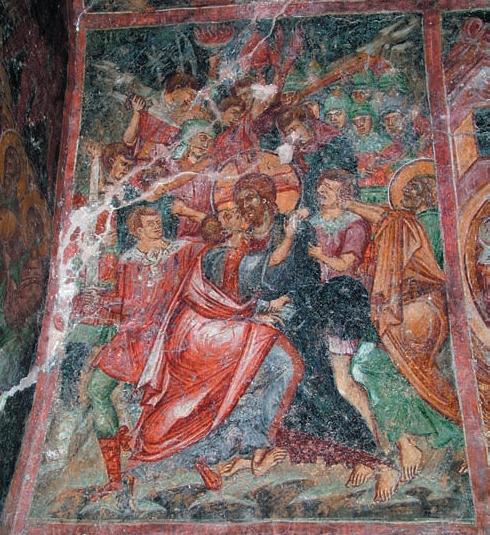Try Amazon Audible Plus

Find the perfect fit with Amazon Prime. Try Before You Buy.
Byzantine soldiers in a fresco of
The Betrayal, Church of Aghios Sotir in Potamies, Byzantine, early 14th century

Fig. 47. The Betrayal, Church of Aghios Sotir in Potamies, 14th c., author’s photo
The frescoes of the Panaghia of Roussospiti, of the early 14th c., in Crete, show a very great deal of equipment in a pure Balkan style (Fig. 44). Details of the mail armour (Λωρικιον) with hauberk (Fig. 45) and of the military footwear (kampagia - fig. 46) are clearly visible on the armed men represented in the mob, who seem to be again the reflex of a local Greek militia.
Also the scene of the Betrayal in the church of Aghios Sotir of Potamies makes the same impression (Fig. 47): but here the left side of the speira is formed by armed brigands, the right side by regular soldiers.
In the Church of Archangel Michael of Kavalariana (Crete), frescoed by the great Iohannes Pagomenos between 1327 and 1328 AD,68 the warriors are dressed in a mixed Western-Eastern military accoutrement, and the chain mail protecting the body of a soldier is shown in realistic detail with alternate rows of iron and bronze rings,69 as in some actual specimens. A padded gambeson is worn by one of the soldiers.
Brimmed helmets are visible on the soldiers arresting Christ in the Church of the Virgin Mary the Myrtiodissa at Gephyra (Crete).70
In the third quarter of the 14th c. the frescoes of Panaghia Phorbiotissa of Asinou, near Nikitari, Cyprus, show the soldiers arresting Christ armed in a mixed Eastern-Western style, brandishing spiked weapons and torches.71 They not only wear scale armours (Κλιβανια), but the group on the left is protected with scale, mail and organic padded corselets, while the group on the right is clad in corselets of small scales and chain-mail alternated again in different rows of iron and copper-alloy rings, as in the Kavalariana Church. The red and grey helmets are fitted with flexible mail aventails. The various specimens of represented armours were all still in use in the 14th c., so the artist did not borrow them from older prototypes, but copied them from real soldiers of his age. Also it is significant that the Chiliarchos is armed with a mace as symbol of command and further protected by a shield, and also the officer of the opposite troops is armed in the same way, but without shield.
68 Cultural Association of Kandanos 1999, p. 69.
69 Cultural Association of Kandanos 1999, p. 81.
70 Cultural Association of Kandanos 1999, pp. 106, 129 (in this page erroneously referred to the Church of Saint Mary of Spina).
71 Stylianou, Stylianou 1992, p. 575ff., Pl. 319.
BIBLIOGRAPHY
Cultural Association of Kandanos 1999 The Byzantine Churches of Kandanos, Chanià.
Stylianou A., Stylianou J.A. 1992 The militarization of the Betrayal and its examples in the painted Churches of Cyprus
pp.89-91, Raffaele d'Amato The Betrayal: Military Iconography and Archaeology In The Byzantine Paintings Of The 11th-15th C. AD Representing The Arrest Of Our Lord
See also Varangian Guard(?) in The Betrayal, Mural in Aghios Georgios, Missolourgaki, Crete, 1401AD.
Other Byzantine Illustrations of Costume & Soldiers
Other 14th Century Illustrations of Costume & Soldiers

